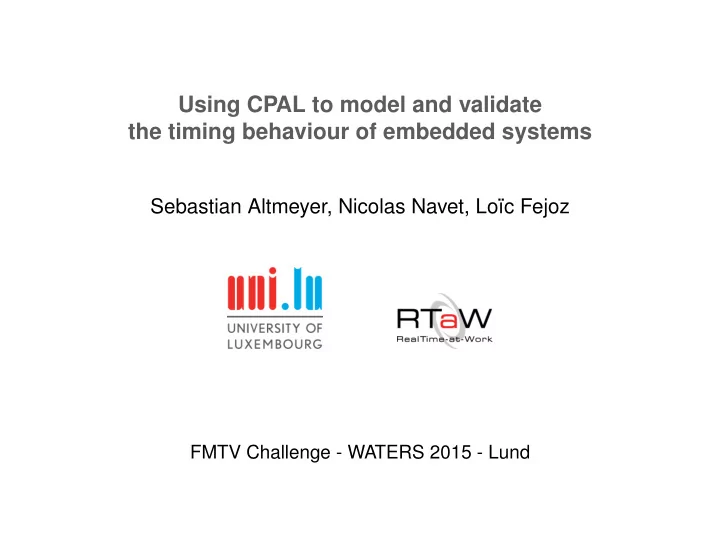

Using CPAL to model and validate the timing behaviour of embedded systems Sebastian Altmeyer, Nicolas Navet, Lo¨ ıc Fejoz FMTV Challenge - WATERS 2015 - Lund
Cyber Physical Action Language (CPAL) ◮ C-like intuitive language (with automata and real-time abstractions) ◮ model functional and temporal behaviour of CPS ◮ simulate CPS (both types of behaviour) (still under development) 1 / 11
The challenging part of the challenge ◮ not a standard scheduling problem ◮ hidden ambiguity in the model ◮ pen & paper solutions seemed trivial How to solve the challenge with CPAL ◮ low effort to model the challenge ◮ quick simulation results ◮ explicit dis-ambiguity (yet, simulation � formal verification) 2 / 11
CPAL Model of Challenge 1 struct Frame { uint32: id; uint32: emission_time; }; processdef T1_PreProcessor( in channel<Frame>: input, out channel<Frame>: output) { state Main { /* removes reflections normalizes intensity, etc. */ assert(input.notEmpty()); output.push(input.pop()); } } var queue<Frame>: cam_to_t1[1]; var queue<Frame>: t1_to_t2[1]; var Frame: t2_to_t3; var queue<Frame>: t3_to_t4[n]; var queue<Frame>: t4_to_monitor[1]; process T1_PreProcessor: t1[cam_to_t1.notEmpty()](cam_to_t1, t1_to_t2); @cpal:time { t1.execution_time = 28ms; } ... 3 / 11
Explicit Disambiguation ◮ task release times ◮ mutable or immutable clock drifts ◮ clock drift distribution ◮ execution time distribution always the least-favorable configuration chosen 4 / 11
Simulation of Challenge 1A n = 1 n = 3 0.03 0.025 0.025 0.02 0.02 0.015 Frequency Frequency 0.015 0.01 0.01 0.005 0.005 0 0 8 9 1 1 1 1 1 1 8 1 1 1 1 1 2 2 0 0 0 1 2 3 4 5 0 0 2 4 6 8 0 2 0 0 0 0 0 0 0 0 0 0 0 0 0 Latency Latency ◮ 10 8 frames in total simulated (in less than 8 hours) ◮ 10 3 release patterns, 10 5 frames per pattern ◮ mutable drifts ◮ normal distributions 5 / 11
Simulation vs. Pen & Paper buffer (n) frame simulation pen & paper 1 1 63 ms 63 ms 1 > 1 89 . 7694 ms 89 . 6656 ms min 3 1 63 ms 63 ms 3 > 1 90 . 0226 ms 89 . 6656 ms 1 - 144 . 9224 ms < 146 ms max 3 - 222 . 9026 ms < 226 ms Error in first pen & paper solution identified using simulation 6 / 11
Simulation of Challenge 1B n = 1 n = 3 0.8 0.7 0.2 0.6 0.15 0.5 Frequency Frequency 0.4 0.1 0.3 0.2 0.05 0.1 0 0 3 3 4 4 5 5 6 0 5 0 5 0 5 0 0 1 2 3 4 5 0 0 0 0 0 0 0 0 0 0 0 0 0 0 0 0 0 0 0 number of frames between two discarded frames number of frames between two discarded frames ◮ 10 8 frames in total simulated (in less than 8 hours) ◮ 10 3 release patterns, 10 5 frames per pattern ◮ immutable drifts, worst-case clock drifts ◮ normal distribution of exec time 7 / 11
Simulation of Challenge 1B: Observations n = 1 n = 3 0.8 0.7 0.2 0.6 0.15 0.5 Frequency Frequency 0.4 0.1 0.3 0.2 0.05 0.1 0 0 3 3 4 4 5 5 6 0 5 0 5 0 5 0 0 1 2 3 4 5 0 0 0 0 0 0 0 0 0 0 0 0 0 0 0 0 0 0 0 number of frames between two discarded frames number of frames between two discarded frames ◮ minimal distance: 2 ◮ minimal distance > 3800 ◮ overload situations ◮ no bursts ◮ lost frames very frequent ◮ two spikes No pen & paper solution to 1B. 8 / 11
CPAL Model of Challenge 2 9 / 11
Simulation of Challenge 2 ◮ CPAL simulation does not yet support pre-emption ◮ taskset T 5 , T 6 , T 7 mutually non-pre-emptive (simulation possible) ◮ taskset T 5 , T 6 , T 7 treated as artificial task Tx : ◮ ⇒ reduction to standard response-time analysis! 10 / 11
Conclusions CPAL doesn’t offer automated formal verification, but: ◮ intuitive modelling ( < 4 hours for the both challenges) ◮ quick simulation ( < 8 hours for all simulations) ◮ unambiguous description Integration with formal verification tool future work.
Recommend
More recommend